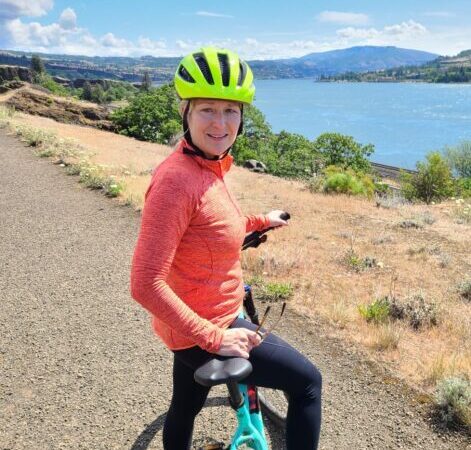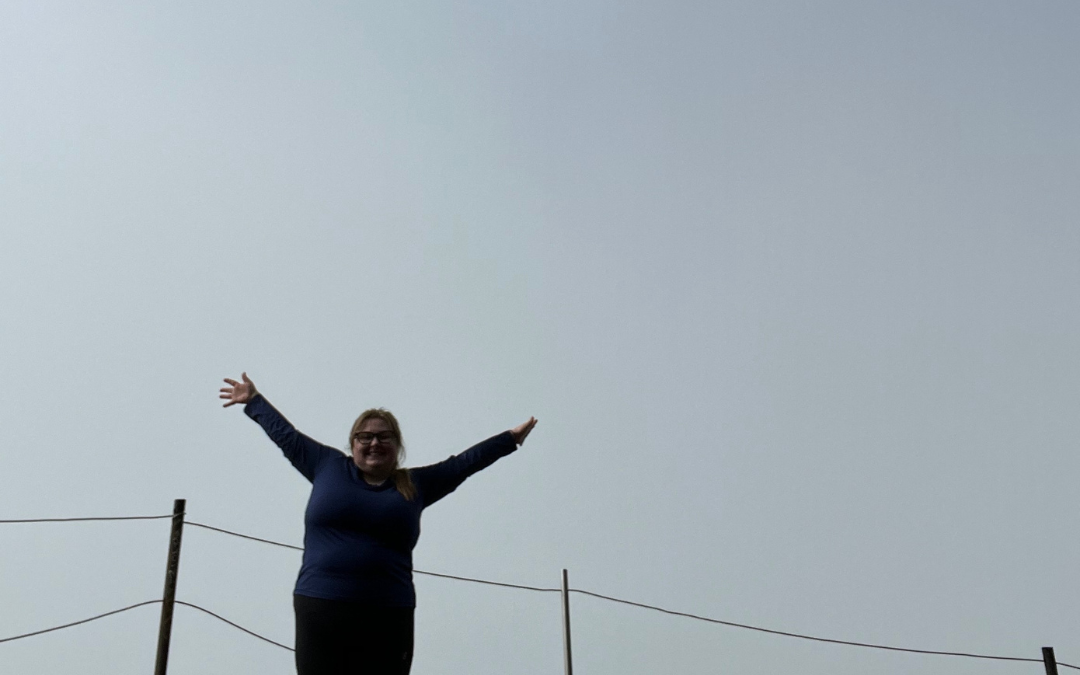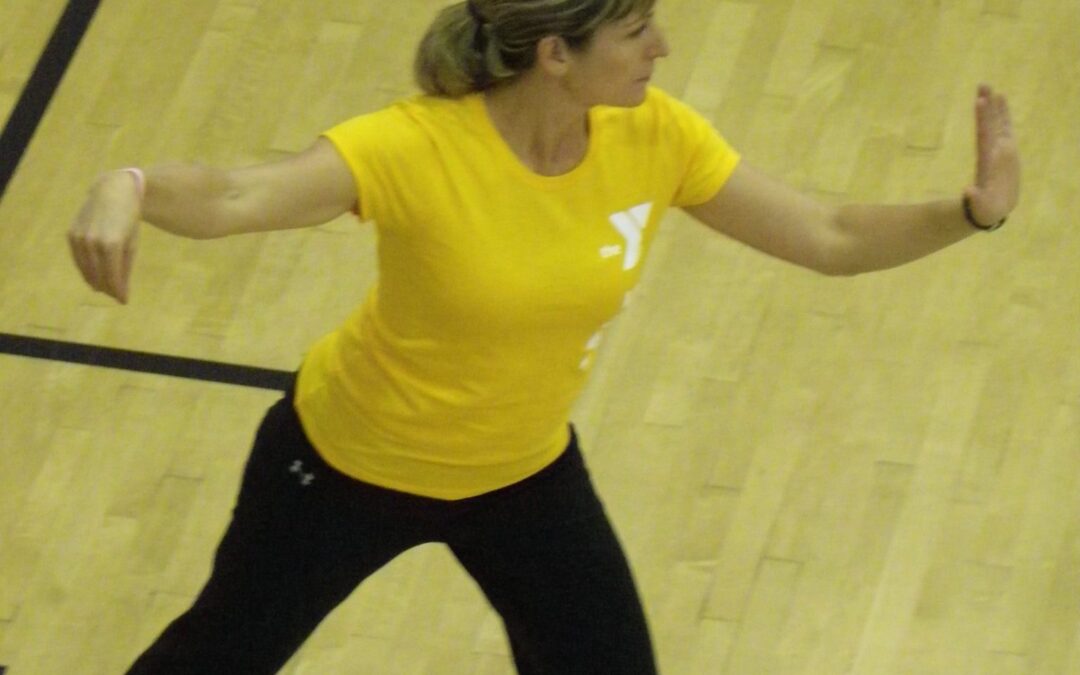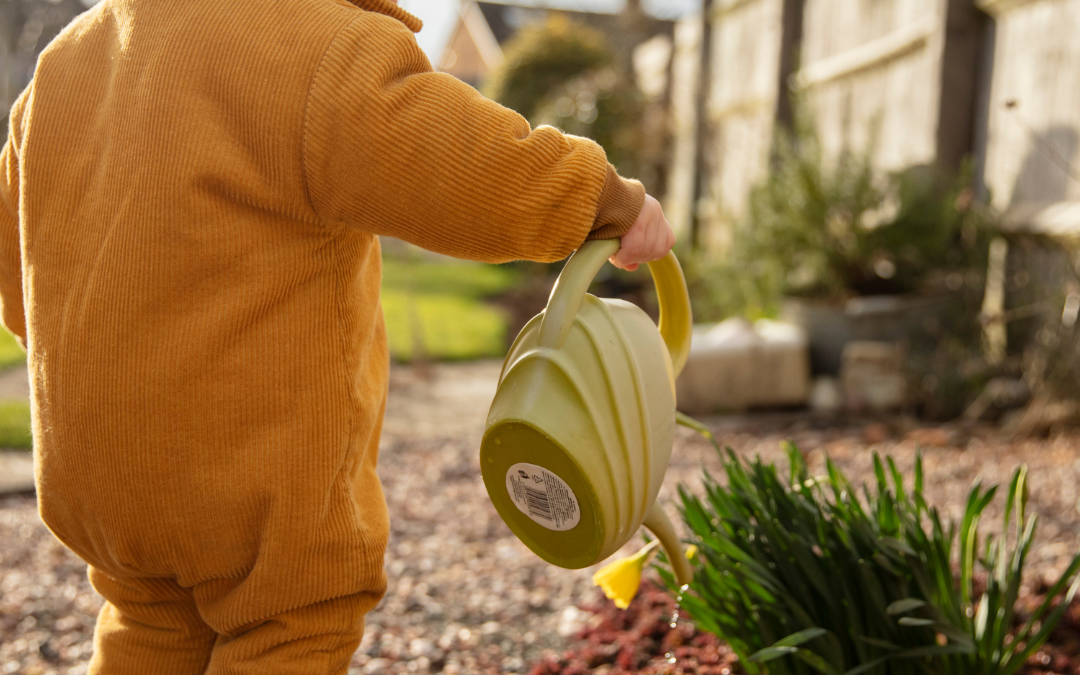
by Michelle | Nov 1, 2024 | Being Well, Featured, Move Well, Why I'm In
Why I’m “in” with Wellness
Michelle Jenck, Well-Being Director, Adventist Health Tillamook and Tillamook County Wellness Coordinator
Wishing for Wellness
I was recently asked how I came to be involved in wellness work. I’d like to say I was a lifelong fitness enthusiast but that isn’t true. As a child, I wanted to be physically fit and athletic but, alas, it was not in the cards for me. Severe asthma left me breathing into a brown paper bag on the sidelines and a debilitating eye condition called amblyopia, (my left eye is nearly blind), meant that, with no depth perception, I was to forever be, the “last one picked for the team.”
During middle school, I was too young to work, old enough to be home by myself but idle enough to have begun getting in trouble (serious, trouble). My saving grace was wandering into a YMCA to kill time after school. I started going to the weight room and pushing weights around. I had no idea what I was doing but kind people showed me what to do and what muscles I was working. It felt so good to feel a sense of control moving my body. I could push heavy things on purpose and muscles would form in places that were once squishy bits. It was like magic.
The best part was how weight training made me feel emotionally. I felt happier and gained a sense of control (something I have learned we need for good mental health, called a “locus of control.”) My self-esteem improved. I could set goals for myself and work to reach them, building successes I never believed possible for myself. I pursued weight training all through high school and was one of a few girls that joined the school’s newly formed competitive power lifting team.
My senior year in high school, I decided maybe I could push my body in other ways and began my first attempts at running. Initially, I “ran” 1-2 blocks and then sat on a curb breathing into a paper bag until my asthma attack subsided enough to slowly walk home. Tenacious and undaunted, I kept after my goal, gradually working my way up to running 2-3 miles at a time, and ultimately up to 6 miles over as many years. Running, even at a slow pace, helped me burn off stress and was a convenient way to get in a quick bout of exercise when I didn’t have time to hit the gym.
Working in Wellness
Through high school, college and into my young adult life, exercise was a staple. I tell people it should be like brushing your teeth; something you do every day without even thinking about it, because it is so ingrained in your routine.
As a stay-at-home mom, I was taking classes at the Tillamook YMCA, grateful to spend time among adults. One day, I made the fateful decision to ask Jeannie Christensen if there was ever going to be a step aerobics class offered at the Y. Like so many things in a small town, the answer was, “why don’t you start one?” Thus began a nearly 30-year career of teaching many different exercise disciplines.
I loved (and still love) teaching fitness classes. It is a way to give back, helping others experience their best life. Over all these years I have seen fitness change people from the inside out. That “locus of control,” it turns out, is an important component of life success and resilience. When we become aware of and gain control over moving our bodies, using our minds, it is very empowering.
The A-Ha Moment
By this time, our oldest son had been diagnosed with autism and our lives were changing dramatically. As we worked with our son to help him develop the ability to regulate his emotions and manage the sensory stimuli causing so much turmoil in his mind and body, I discovered magic could be found in movement. The most effective exercises involved movements that strengthened the parts of his brain involved in balance, spatial awareness and motor planning. How interesting, I thought. The same could be said for teaching a step class.
Teaching adults how to move, while helping our son re-wire his brain with movement, turned out to generate an “a-ha” moment of monumental proportions. As I began to understand how the brain is formed and how it changes with regular physical activity, I began to consider the larger implications of what I was learning. What could this mean for other children? For anyone who wanted to be more physically coordinated, better regulated, smarter and more successful?
Armed with this discovery, I decided to go back to school to pursue a Master of Education in Health & Kinesiology. Graduating in 2012, I used my degree to expand exercise programming at the YMCA, adding Tai Chi: Moving for Better Balance, which over 300 older adults took in 2014. The following year, I was tapped to help lead a community effort to focus on reducing chronic disease in Tillamook County, which led to the formation of Tillamook County Wellness.
My Hopes for Wellness
I am very grateful for my experiences and the opportunity to influence health at both the individual and population level. As I enter my ninth year as coordinator for Tillamook County Wellness, I am looking ahead; or better yet, I am looking further “upstream.” So much of what contributes to wellness can be found between our ears. The mind. The brain. The connection between the brain and the body. This is where wellness starts. And it starts early in life – in the womb, in fact. Nearly 90% of a child’s brain is developed by the age of three and much of that development depends on movement.
My hopes for wellness are that we will begin to prioritize proper movement, nutrition and secure relationships during this critical window of childhood development. Do I have ideas for this? You bet I do and I can’t wait to keep working on wellness!

by Michelle | Aug 10, 2024 | Being Well, Featured, Move Well, Uncategorized
August is a busy month! There are several free wellness activities coming up, some of which you can learn more about at the Tillamook County Fair.
“Treasure Your Wellness” Treasure Map: This interactive map can be found at the Tillamook Library bookmobile located near the Master Gardener’s garden by the east entrance of the fairgrounds. This fun, free, and family-friendly adventure runs From August 5th to September 30th . Explore wellness destinations like Activity Island, Be Well-Nourished Bay, Community Cove and the Isle of Inner Peace. Each location includes activity challenges —volunteer, cook a healthy meal, visit a rec center, start a savings account and more. Complete at least one activity on each island and you could win incredible wellness-themed prizes, like cornhole, pickleball, and disc golf sets or the grand prize of an ATX bike valued over $500! In addition to being available at the fair, maps can be found at local library branches, Kiawanda Community Center, Tillamook YMCA, North County Recreation District and Food Roots or on- line at This Way to Well-Being | Tillamook County Wellness.
Health Literacy Campaign: Materials from our recent health literacy campaign can also be found at the Tillamook Library booth at the fair. Bookmarks and other materials highlighting important health information like finding a primary care provider, getting vital health screenings and knowing when to visit your doctor, urgent care or emergency department, are just a few topics covered. You can also find more information here. Community Health Survey: When you visit the Library Bookmobile at the Fair, be sure to take our Community Health Needs Survey. Tell us what you and your family most need to live your best life and your areas of greatest concern impacting your health and well-being. You can also take the survey here.
Financial Wellness: Visit the Habitat for Humanity booth – located in the main pavilion building, under the stairs near the fair office – for community conversations on what financial health means to you. While you are there, learn more about first-time home buying and other ways you can work toward your financial goals. While you are at the Habitat for Humanity booth be sure to sign up for:
- FUNancial Wellness Event – Come to the Tillamook YMCA, Monday, August 19th, 2024, 5:00- 6:30 PM for food, fun and financial learning opportunities for kids 3rd -6th grade. This FREE event provides kids and families an opportunity to learn about saving, spending, growing and protecting money. Kids will take home more than just knowledge with free giveaways and prizes. Learn more and register for the event here.
- Sign Up to become a “FinLit” Financial Literacy Volunteer – This program relies on volunteers to deliver free curriculum from Financial Beginnings. Classes are held in English & Spanish at multiple community locations, including Tillamook Bay Community College, Helping Hands, and Trask High School.
Volunteers can commit to as many or as few classes as works for their schedule. To learn more or to register to become a volunteer, visit Financial Beginnings (finbeg.org). If we don’t see you at the fair, here are other ways you can get information about these and future wellness events.
AUTHOR: Michelle Jenck, Adventist Health Tillamook Director of Community Well-Being

by Guest | Apr 24, 2024 | Being Well, Featured, Uncategorized, Why I'm In
“WHY I’M IN …” An interview with Emery Edwards, AmeriCorps, VISTA
What drew you/your organization to partner with Tillamook County Wellness?
I’ll be honest, I started working with TCW because it was something required of my position as an AmeriCorps VISTA volunteer. I came to Tillamook, though, because I was in search of something more fulfilling, authentic, and close to nature than what I had built in Seattle. Since the first day I learned about TCW I was inspired by the community-driven initiatives to make Tillamook a better place to work, live, and be. I will continue my work with TCW because I am inspired by the passion exhibited by its members towards the never-ending work of improving this county. I have found that TCW embodies what I was searching for when I moved to Tillamook- it is authentic, innovative, fulfilling, and emphasizes genuine relationships and community action.
What, if any, changes have you seen come about as a result of this work?
I can see how TCW brings organizations and people together for initiatives to improve the county. Being behind the scenes and involved in several committees I have the unique opportunity to see so much of what TCW is doing! The collaborative nature of the committees creates buy-in throughout organizations in the county and provides a platform for the exchange of ideas all towards the betterment of our community. I specifically see how a lot of what TCW does is directly informed by data collected about the greatest needs of the county, specifically for vulnerable populations. I see access to care and access to physical activity being increased for all of Tillamook County, but particularly emphasized for historically underserved populations. This is critical work that is not being done everywhere and I’m so happy that TCW is taking that initiative.
What have you learned from being involved in this work?
Gosh, I have learned so much about what it means to bring about community action. This community has so many wonderful members who are passionate about improving the livelihoods of all county residents which has restored some of my faith in humanity. I learn so much from my work with TCW almost every day, but I think the biggest thing I’ve learned is that community action like TCW is even possible!
What are your hopes for this work as it relates to you/your organization?
I hope that this work can continue to grow and expand to include more representatives of the community. I really hope to see more community members, retirees, and other people looking to use their time, energy, and skills to better their community through TCW. I hope that this will cultivate a sense of ownership for Tillamook County residents. In my experience, if you yourself work on something you feel a sense of ownership over it. And that’s really important for this program’s sustainability. The more people come together wanting to improve their community through TCW the more positive impact we’ll be able to make
What are your hopes for this work as it relates to changing community health in Tillamook County.
Moving to Tillamook County has changed my life, and I know it can change so many others. I really hope that this work will improve access to a happy and healthy life for all. It’s really hard to not have any healthy habits, nutritional knowledge, or a healthy relationship with your body. I believe that TCW is providing access to healthy choices we can make for ourselves. This is essential work to improving community health because when you feel like you’re on your own with your health, it’s really isolating and it can feel like you have to reinvent the wheel. TCW is changing Tillamook County for the better, and my biggest hope is that we continue to receive support from the community we serve.
Is there anything else you’d like to share?
I would just like to add that moving to Tillamook County has changed my life for the better! I’ve been able to build a wonderful community of authentic, caring, amazing people who truly care about this community. Tillamook County has its flaws but it is such a special place to me and I am so grateful to have had the opportunity to serve here. I am so looking forward to seeing what amazing things we can accomplish with community action! And, a special thank-you to Michelle Jenck, the Tillamook County Wellness Coordinator. Without her, so much of this work would not be possible!

by Guest | Apr 4, 2024 | Being Well, Featured, Move Well
In our busy lives, there is much to pull our focus and distract our minds as we move through our day. The constant buzz of the phone in our pocket, ever-present screens, and ambient noise from a world in constant motion contribute to all the distractions. All of these disturbances lead to inattention and are not ideal for our bodies or minds. This is where the concept of mindful movement can come into play. Using mindful movement helps to increase awareness of your body, which, in turn, will help increase the enjoyment of activities, improve mental focus, and reduce stress. This article will help you explore the benefits of mindful movement and simple methods of incorporating mindfulness into your daily life.
What is Mindful Movement?
Mindful movement is creating an awareness of your body by bringing your full attention to the present moment and the current activity you are engaging in. Mindful movement is done without the intent of judging yourself. Instead, you are acknowledging how the body feels and responds to movement. The difference between exercising and practicing mindful movement is intent. You can exercise by merely going through the motions of the movements with the hope of seeing physical benefits. However, with mindful movements, you notice things like your breathing, how the floor feels under your feet, and the stretch in your muscles as you move them.
Mindfulness originally started as a form of meditation. It became more mainstream as yoga gained popularity, and mindfulness was frequently added to the end of a yoga practice. Practicing mindful movement with exercise then expanded to other forms of exercise, including Pilates and stretching. However, mindful movement is not limited to just formal exercise. It can be incorporated into the things you mindlessly do every day, such as walking the dog or sitting at your desk while working.
The Benefits of Mindful Movement
As the practice of mindful movement grew, so did the research showing the benefits of moving mindfully.
- It is generally accepted that exercise reduces stress and improves emotional well-being. The practice of mindful movement is no exception. Mindful-based interventions show a reduction in anxiety, depression, and stress equivalent to psychological interventions.
- Reducing stressors has the additional benefit of improving immunity. Stress is known to suppress immunity by triggering an inflammatory response. By utilizing methods of reducing stress, you can experience boosted immunity by interrupting the inflammatory response pathways in your body.
- Routinely practicing mindful movement will help improve sleep. The average adult needs 7-8 hours of sleep a night. Mindful movement can help achieve this amount of sleep and improve the quality of the sleep you get.
- Improved focus, concentration, and control of ADHD symptoms have been observed in adults and children who routinely practice mindful exercise, such as tai chi, yoga, and dance.
- Proprioception is the body’s awareness of its place in the space around it and how it moves through space. Mindful movements will improve proprioception. This occurs by using the brain and body connection to retrain the body with new motor skills. These new skills help reduce falls by improving balance.
Examples of Mindful Movement
Mindful movement is for everyone, not just athletes and those who exercise regularly. Mindful movement can be incorporated into your daily activities with both structured and unstructured activities.
Structured:
- Yoga
- Pilates
- Strength training
- Stretching
- Tai Chi
- Qigong
Unstructured:
- Freestyle dance, turn the radio on and let loose
- Singing in the car
- Playing games with children
- Gardening
- Walking your dog
- Washing dishes
- Driving
Begin Moving Mindfully
You can start your practice of moving mindfully at any time and easily incorporate it into your daily routine. There is no need for athletic equipment. No level of activity is too small to add mindfulness to it. You can quickly begin with a walk, seated yoga, stretching, or by adding mindfulness to your current exercise routines. Here are some tips to get you going.
- Add to everyday activities: Focus on basic activities like walking, breathing, gardening, or gentle stretching.
- Minimize distractions: Turn off your phone for the duration of your mindfulness practice. Find a quiet space away from others where you can really focus your mind without interruption.
- Focus on breathing: Use your breath to regulate your mind. Slow, deep breaths help to slow your mind and keep you in the present moment.
- Engage your senses: Pay attention to the sounds around you. Can you smell wet rain on the ground or the fir tree in your yard? Reach out and touch trees, rocks, and flowers as you walk.
- Pay attention to your body: Acknowledge any aches or pains, but do not dwell on them. Notice how your hair moves as the wind blows through it, how the ground feels under your feet, or the movement of your muscles with the activity. If your mind wanders, gently bring your attention back to your body.
Starting small with activities you already do in your daily life makes it easy to add mindful movement gradually. Begin with activities you enjoy or that fit into your lifestyle. Taking the time to pay attention and focus on your movements allows you to gain a new appreciation for the amazing piece of machinery that your body is. By focusing on your body, you are doing more than simply going through the motions of an activity. So remember to be patient and kind to yourself by focusing on progression, not perfection.
Resources:
https://www.sciencedirect.com/science/article/abs/pii/S0272735817303847?via%3Dihub
https://davidvago.bwh.harvard.edu/why-mindfulness-can-help-the-immune-system/
https://pubmed.ncbi.nlm.nih.gov/26802824/
https://www.ncbi.nlm.nih.gov/pmc/articles/PMC4484342/
https://www.ncbi.nlm.nih.gov/pmc/articles/PMC4309156/
Written by Leanna Coy

by Guest | Mar 2, 2024 | Being Well, Featured, Move Well, Uncategorized
As spring approaches, a sense of excitement fills the air among local gardeners as they prepare to kickstart their seeds and condition their gardens for the upcoming abundance of fruit and vegetable starts. It’s also a great time to involve children in the excitement of planning and starting a gardening!
Being surrounded by the temptations of technology, encouraging kids to get outside and engage with nature can be a challenge. Gardening is a valuable tool to captivate their interest, offering a hands-on approach to exploring their outdoor world.
As kids dig into the soil, sow the seeds, and tend to the plants, they develop a sense of ownership and responsibility. The act of caring for the seeds instills the concept of delayed gratification, offering a reward that comes from consistently caring for something over time. In our fast-paced “microwave society,” it can be an advantage for our children to understand that things require time and patience to grow.
Let’s explore some entertaining and budget-friendly ways to introduce kids to the joy of gardening!
• Craft environmentally-friendly seed pots using recycled newspapers. This engaging activity not only prepares for planting but also serves as an excellent rainy day project.
• Utilize everyday items like recycled yogurt or cottage cheese containers, and even milk jugs that are cut in half. Remember to poke a few small holes in the bottom for proper drainage.
• Use eco-friendly items like eggshells, egg cartons, or orange peels as planting containers. These can be directly planted in the garden, where they will biodegrade.
• If space is limited, sow seeds directly into a large pot or bucket, creating a compact and manageable container garden. This is ideal for patios or areas with minimal space.
• Capture your child’s interest by aligning the garden with their passions. Consider a pizza garden with basil, oregano, tomatoes, and onions. Or create a fairy garden, allowing them to plant flowers or succulents and add them to the container with fun trinkets.
• Foster excitement by planting something that grows taller than your child. Dill, with its tall and frilly leaves, or classic sunflowers, make for excellent choices.
• Opt for fast-growing options like radishes, lettuce, and some bean varieties, providing a sense of accomplishment as your little ones get to harvest their crops in no time.
By adding in creative and budget-friendly ideas, you’re helping cultivate a love for gardening and sparking the imagination of the young green thumbs in your life!
For more information on starting and growing a garden, visit: https://foodhero.org/gardening
For more local health and wellness information, visit www.tillamookcountywellness.org or follow Tillamook County Wellness on Facebook and Instagram.





